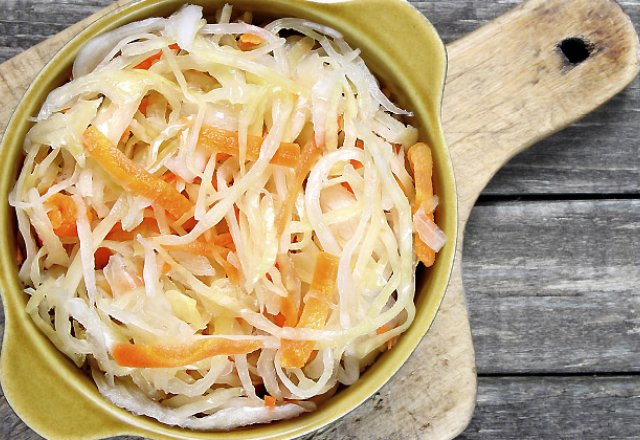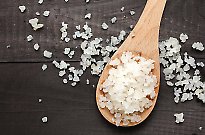
Easy sauerkraut recipe

Incorporate fermented foods into your diet
Supermarket-bought sauerkraut is generally not a source of probiotic cultures due to the preparation process, which kills any beneficial bacteria. So learn how make your own!
Ingredients
- 1 kilo of vegetables per litre, any varieties of cabbage alone or in combination, or at least half a cabbage and the remainder of any combination of radish, turnip, carrot, beet, kohlrabi, Jerusalem artichoke, onion, shallot, leek, garlic, greens, seaweed, peppers, or other vegetables.
- Approximately one tablespoon of salt (whatever type you use; start with a little less if using a coarse grind.)
- Other seasonings as desired, such as caraway seeds, juniper berries, dill, hot peppers, ginger, turmeric or whatever you can conjure in your imagination.
Method
Chop or grate vegetables into a bowl. The purpose of this is to expose surface area in order to pull water out of the vegetables, so the vegetables can be submerged under their own juices. (Fermenting whole vegetables or large chunks requires a salt water brine.)
Salt vegetables lightly and add seasonings as you chop. Sauerkraut does not require heavy salting. Salt and season, to taste. Taste after the next step and add more salt if desired. It is always easier to add salt than to remove it.
Squeeze salted vegetables with your hands for a few moments (or pound with a blunt tool). This bruises the vegetables, breaking down cell walls and enabling them to give up their juices. Squeeze until you can pick up a handful and when you squeeze, juice releases (as from a wet sponge).
Pack salted and squeezed vegetables into your jar. Press vegetables down with force so that juice rises up and over them. Fill jar almost all the way to the top, leaving a little space for expansion. Screw the top on, but be aware that fermentation produces carbon dioxide, so pressure will build up in the jar and needs to be released daily, especially the first few days when activity will be most vigorous.
Wait. Be sure to loosen top to relieve pressure each day for the first few days.
Rate of fermentation will be faster in a warm environment, slower in a cool one.
Some people prefer their ’krauts lightly fermented for just a few days; others prefer a stronger, more acidic flavour that develops over a longer time. Taste after just a few days, then a few days later, and at regular intervals to discover what you prefer. In a cool environment, ’kraut can continue fermenting slowly for months.
The most common problem that people encounter in fermenting vegetables is surface growth of yeasts and/or moulds, facilitated by oxygen. If you should encounter surface growth, simply scrape off the top layer and discard. The fermented vegetables beneath will look, smell and taste fine.
Enjoy your ’kraut! And start a new batch before this one runs out.
For a larger vessel: The process is exactly the same, in terms of ingredients, proportions, preparation and time. The only differences are in the vessel itself. In a crock or other larger vessel, use a weight to keep the vegetables submerged. I typically use a plate that fits inside the crock and sits on the vegetables; a jug filled with water to weigh it down; and a cloth over the top to keep flies away. Some crocks are designed with water locks that keep air out but allow carbon dioxide pressure inside to release.
Time frame: 1–4 weeks (or more) Vessel: 1 litre wide-mouth jar, or a larger jar or crock
This is Sandor Katz’s easy sauerkraut recipe from his book Wild Fermentation: The Flavor, Nutrition, and Craft of Live-Culture Foods (Chelsea Green, 2003).


